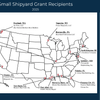Transonic Hull Technology for Offshore Vessels
Maritime Activity Reports, Inc.

By Albert Calderon, Director and Chairman, Transonic Hull Company (THC)
April 13, 2009
Hydrodynamics theory establishes that wave making resistance of displacement hulls originate from their body shape, especially from shoulders, midbody, and rear quarter curvatures of their waterplane at the water-air interface. These curvatures create bow waves, midbody troughs, and stern waves, which set the “hull speed” limit when the distance between bow and stern wave equal the boat’s length (speed/length ratio 1.34). Above hull speed, resistance grows at a high exponential rate. Transonic Hull (TH) technology eliminates this problem by using a slender triangular waterplane with apex at the bow, and rectilinear sides, free of curvatures, extending from bow to a maximum beam at the stern. This shape also generates the sharpest possible entry angle at the bow.













